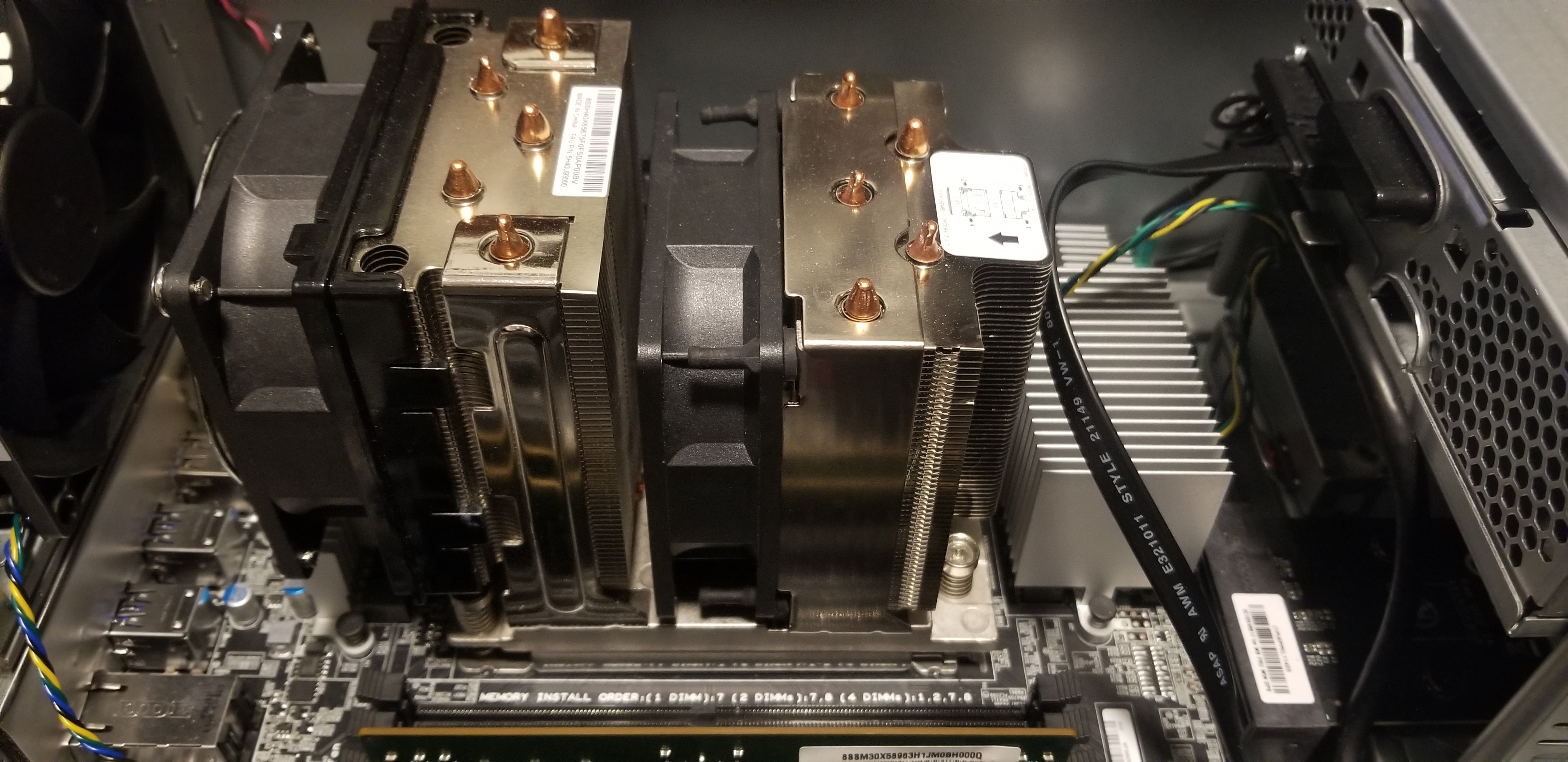Why you can trust Tom's Hardware
AMD Threadripper Pro 3995WX Gaming Performance — The TLDR


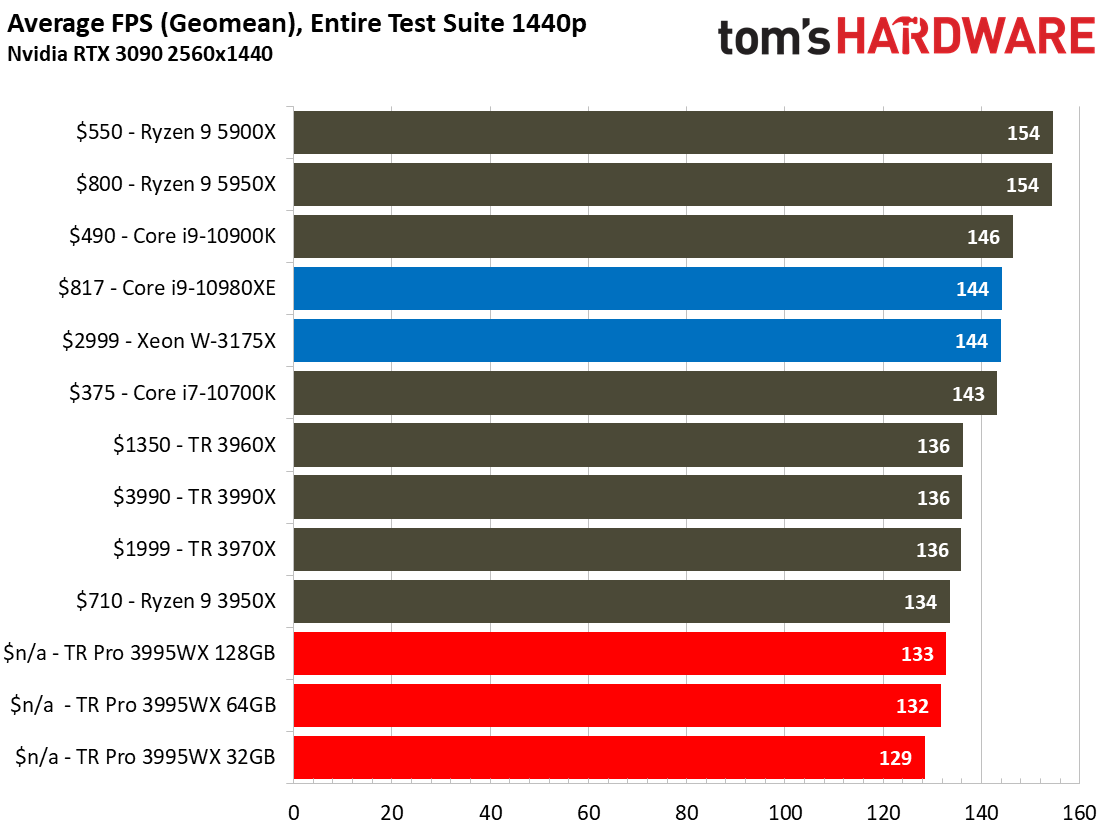
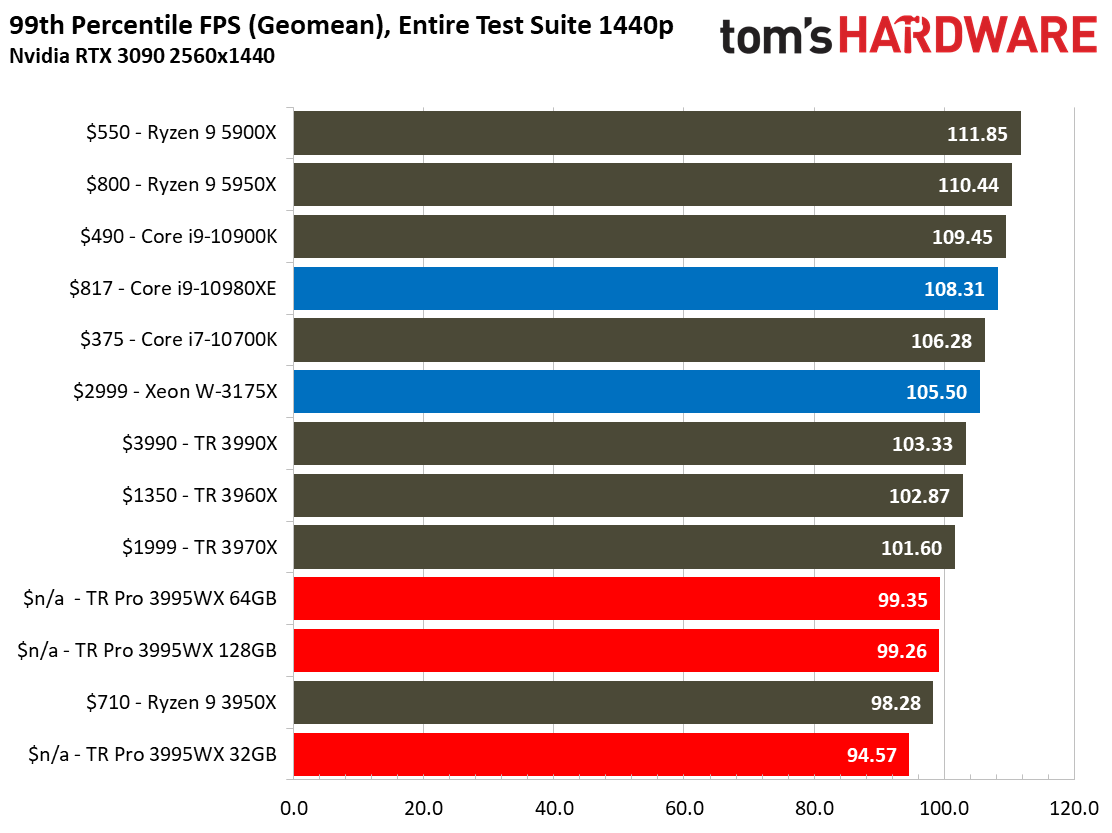
The Threadripper 3990X is in no way intended for gaming, and neither is the Threadripper Pro 3995WX. Yet here we are with a string of gaming tests. Regardless of the Threadripper's intended purpose, we couldn't resist the temptation to see how the chips fare when paired with a high-end GPU. These tests also give us an idea of how increased memory throughput benefits gaming, which should help answer whether or not we would see increased gaming performance with consumer-geared Threadripper models with eight memory channels.
Bear in mind that you absolutely should not base your purchasing decision on these gaming results: The overwhelming majority of enthusiasts should opt for mainstream chips for the best gaming performance and value. Most professional users won't be interested in gaming performance anyway. The Threadripper chips don't impact competitive positioning in the gaming market, so consider this round of tests an exhibition/academic exercise. As such, we'll limit the commentary in the per-game breakdowns below.
With the 3995WX, we see a marked increase in average framerates due to moving from dual- to quad-channel memory, but those gains level out in the octo-channel configuration. That suggests that increased memory throughput isn't a panacea that increases gaming performance in all titles - we have obviously reached a point of diminishing returns.
The Threadripper Pro 3995WX does experience the slightest of performance uplifts from moving from quad- to octo-channel configurations. Still, the additional two fps in our cumulative 1080p results fall close to the expected standard deviation within our test suite. We see even less of an advantage in average frame rates at the 1440p resolution - the gain amounts to less than 1 fps – but the 3990X delivers much better 99th percentile performance at 1440p, implying smoother gameplay.
We're stuck with JEDEC timings for the Threadripper Pro, and tuning those timings could lead to more gaming performance. We do see some variances in our per-game results below, but even if we could optimize the memory timings for the 3995WX, it's clear that the added cost of populating four more memory channels, not to mention the platform-level costs, isn't worth it for gaming.
A quick glance at the consumer-geared Threadripper 3990X tells the story nicely. We've outfitted this chip with all four memory channels populated with a total of 32GB of memory (this is our standard gaming test setup), and its performance matches the 3995WX (with all eight channels populated) at 1080p and 1440p. Mind you, the 3990X does have a 100 MHz higher boost clock, 200 MHz base clock advantage, and tighter 14-14-14-36 timings, but eight channels of memory probably wouldn't equate to a worthwhile boost in gaming performance. It appears that AMD dialed in the 3990X's price-to-performance ratio perfectly for the client market.
The Xeon W-3175X and Core i9-10980XE serve up tangible performance gains over the Threadripper processors in gaming, but as with all HEDT chips, they represent a poor value for gamers given their price points.
Get Tom's Hardware's best news and in-depth reviews, straight to your inbox.
As we can see from the consumer variants, the Ryzen 5000 chips remain the king of the gaming hill, and the Core i9 and i7 processors are no slouch, either. Naturally, these client chips all come at a far more palatable price point.
The Threadripper 3995WX obviously isn't for gaming. However, if a developer decided to unwind with a few games at work, it delivers strong enough performance to deliver a smooth gaming experience.
3D Mark, VRMark, Stockfish Chess Engine on AMD Threadripper Pro 3995WX
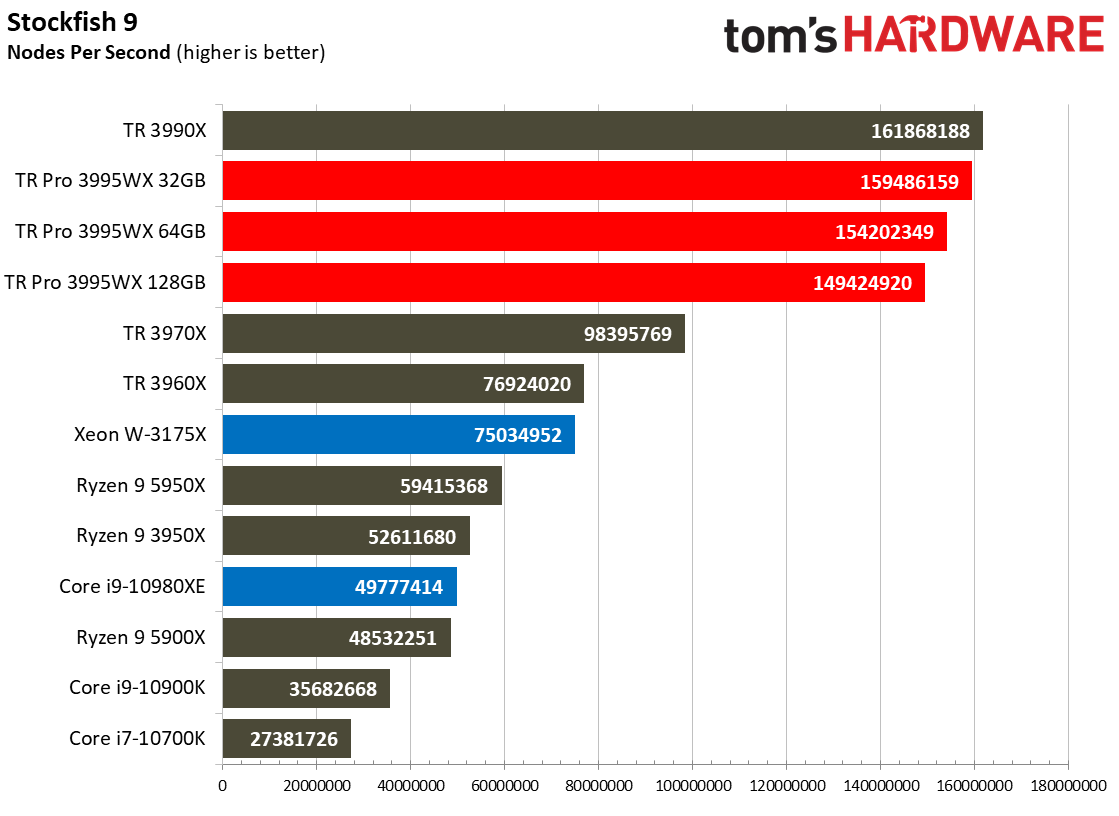
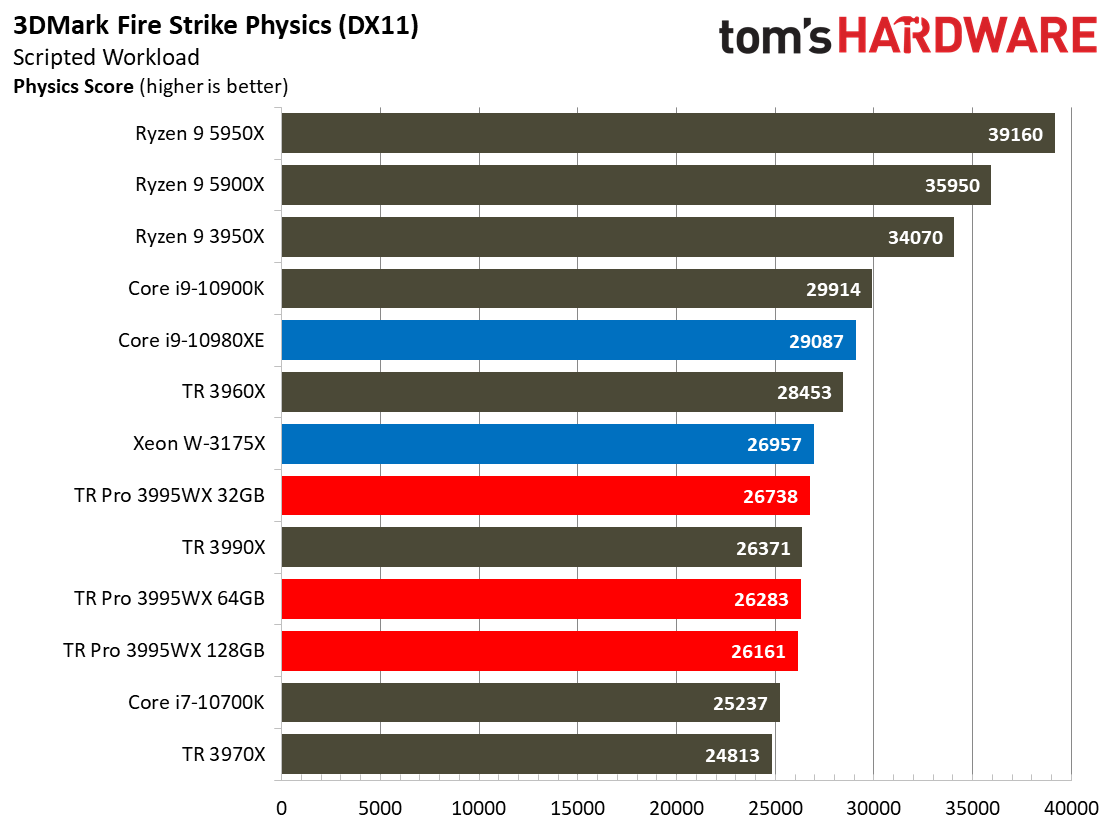
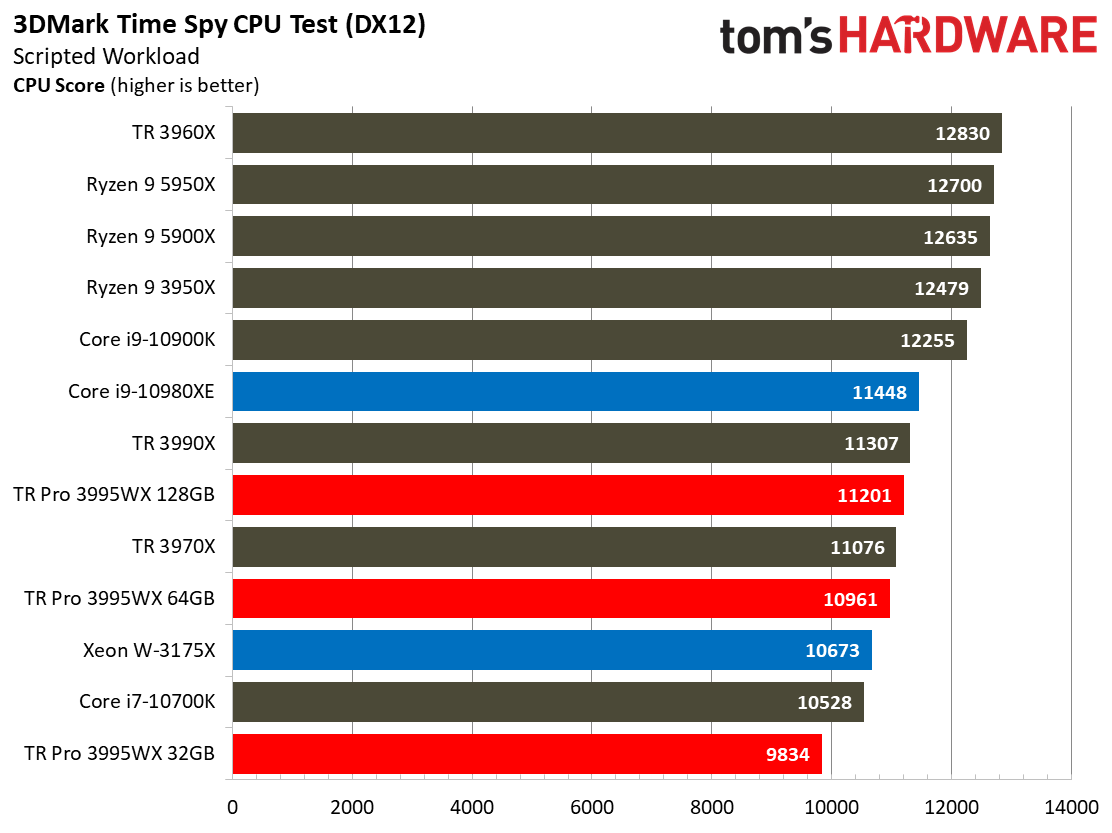
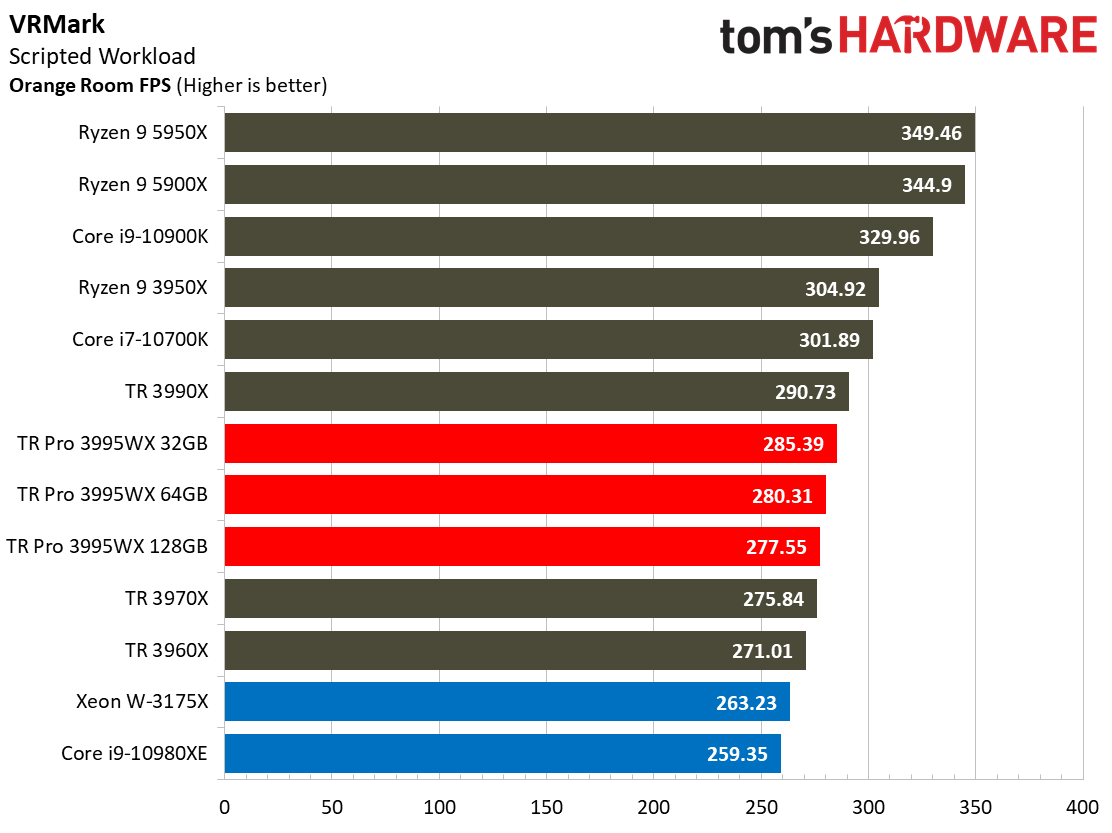
We run these synthetic gaming tests as part of our main application test script. We use an RTX 2080 Ti for these tests to facilitate faster testing, but we use the RTX 3090 for all other gaming benchmarks (we don't include these tests in the geometric mean listed above).
As we've come to expect, AMD's core-heavy processors dominate in threaded synthetic tests, like the Stockfish chess engine. However, the 3995WX's increased memory throughput doesn't improve performance over the 3990X in this benchmark, though it would be interesting to see if it would benefit from tighter timings. Overall, the 3990X's higher clock speeds grant it an advantage.
UL Benchmark's DX11 and DX12 CPU tests also tend to scale well with additional core counts, but those benchmarks obviously aren't optimized for the Threadripper processors. Here we can see the 3990X again leveraging its higher clock speeds to win over the Pro model. Meanwhile, as expected, the consumer-class chips excel in these tests.
Borderlands 3 on AMD Threadripper Pro 3995WX




In Borderlands 3, the 64GB 3995WX configuration takes the slightest of leads at 1080p, but bear in mind that these results fall perilously close to the expected run-to-run variation. At 1440p, 0.1 fps separates the quad- and octo-channel 3995WX setups. Notably, the dual-channel 3995WX configuration trails the other chips, while the quad-channel 3990X leads the other Threadripper processors.
Far Cry 5 on AMD Threadripper Pro 3995WX

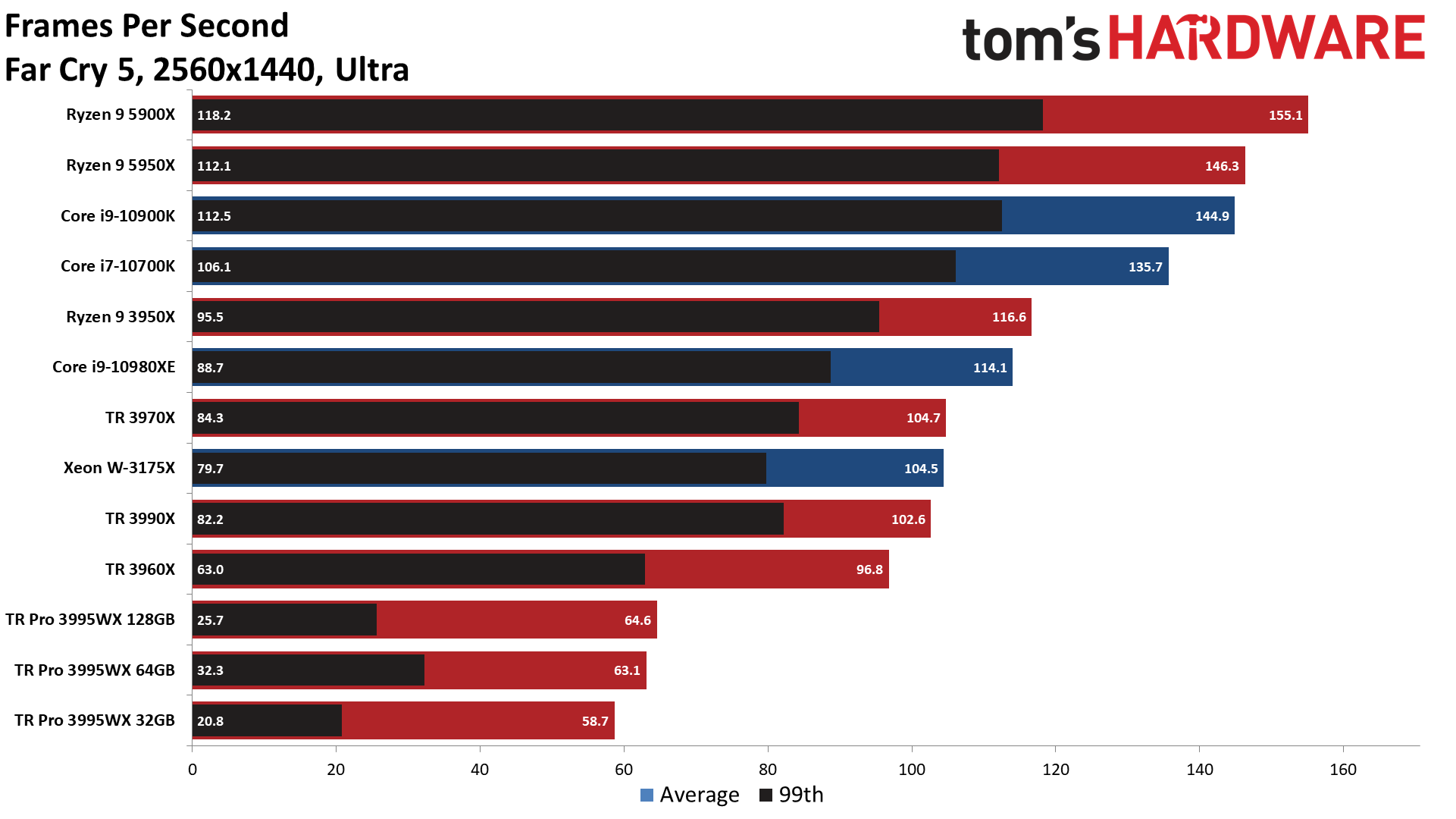
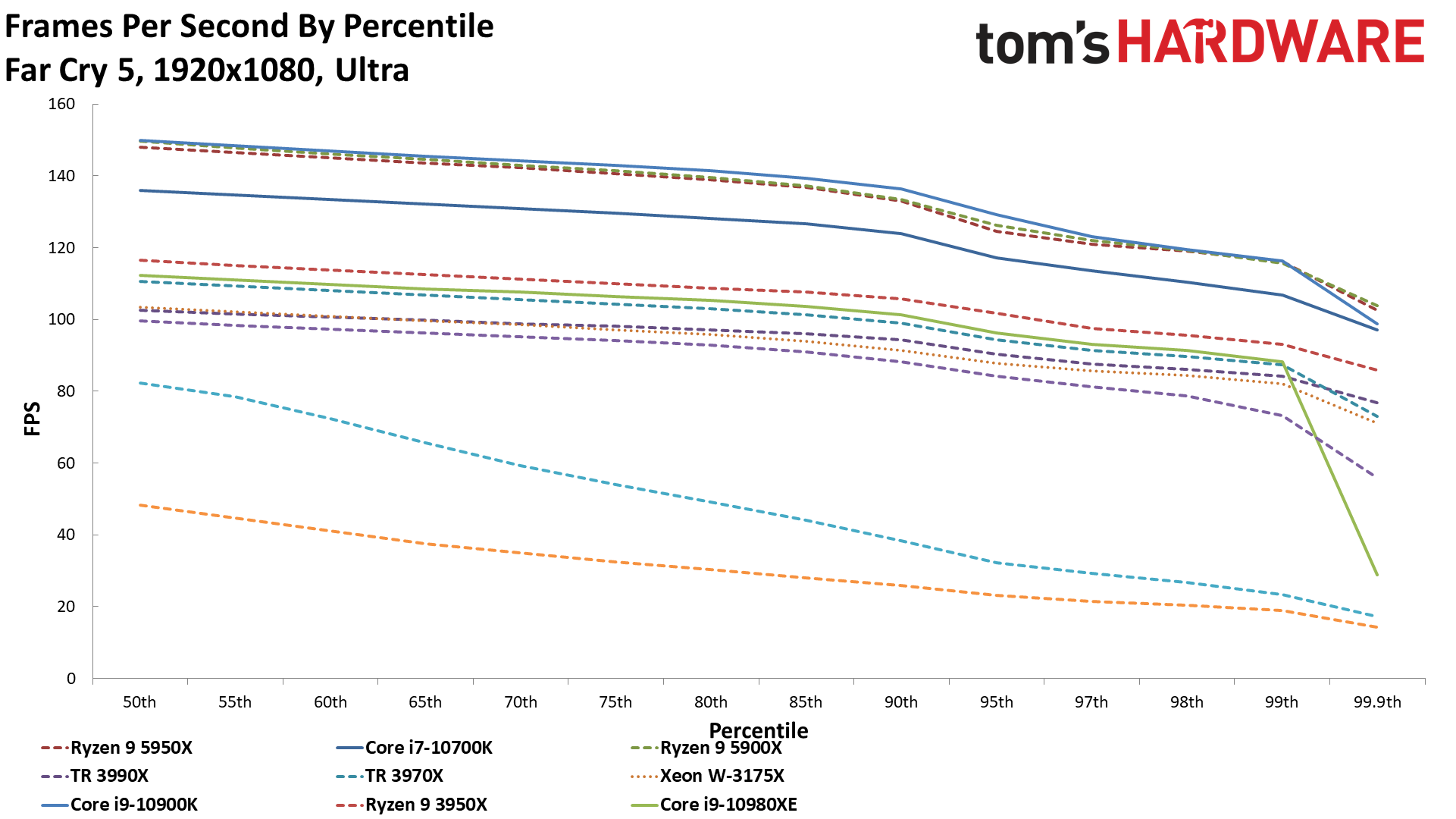

Far Cry 5's unoptimized code incurs a big performance penalty when all cores and threads are exposed to the operating system. For this title, we tested the Threadripper 3990X in 'game mode,' which disables half of the processor to enable compatibility with unoptimized code. This is the only title that required game mode for the Threadripper processors.
The game mode option isn't technically available with the Threadripper Pro 3995WX (Ryzen Master isn't available, but you could enable a quasi-game mode via a Windows command line). Here we can see the result of running the game without this option - erratic and poor performance that isn't indicative of how the processor performs in the overwhelming majority of applications. This performance result doesn't matter for professional users, but it is interesting. (We excluded this benchmark from our cumulative gaming results.)
Hitman 2 on AMD Threadripper Pro 3995WX
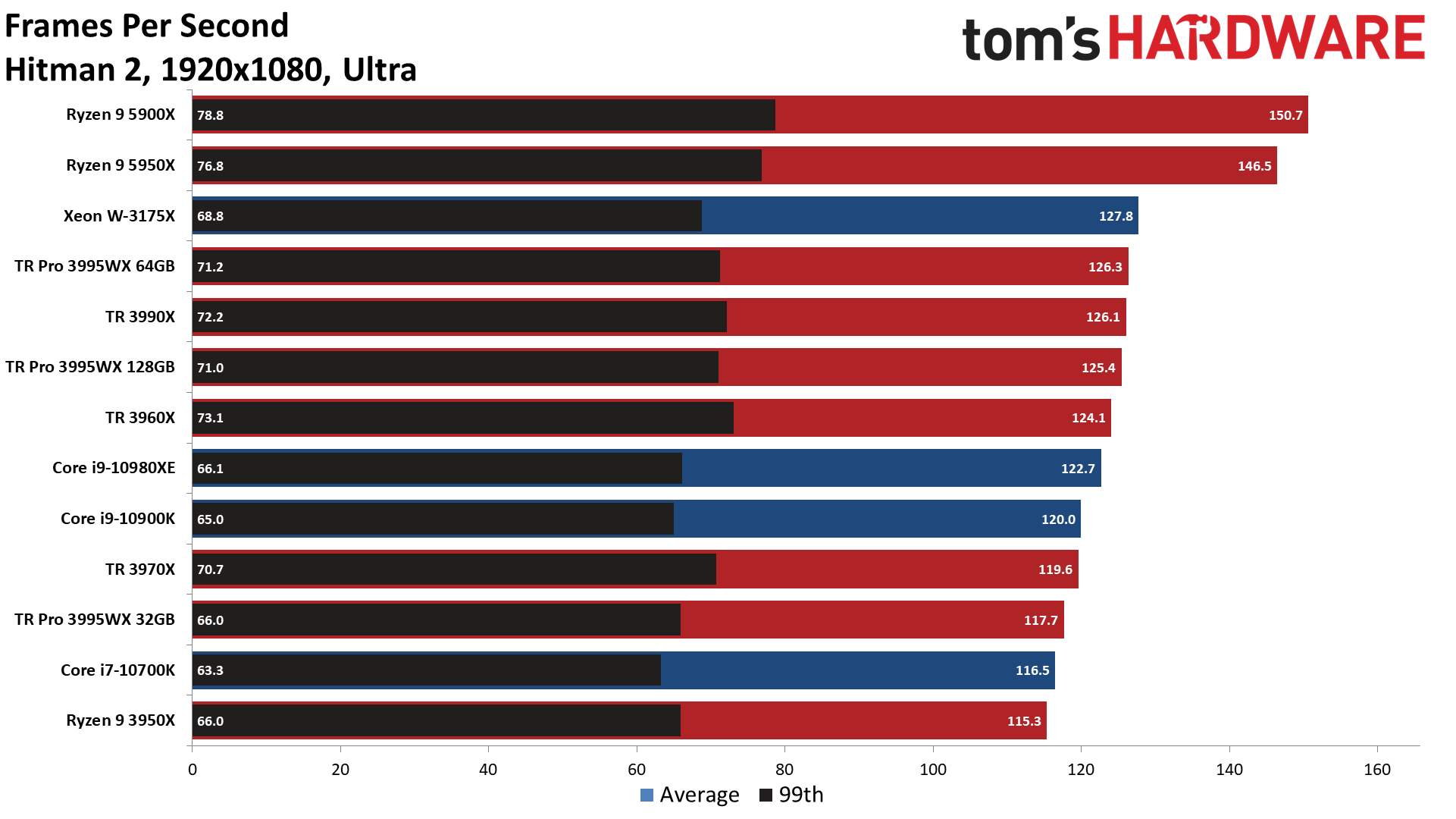
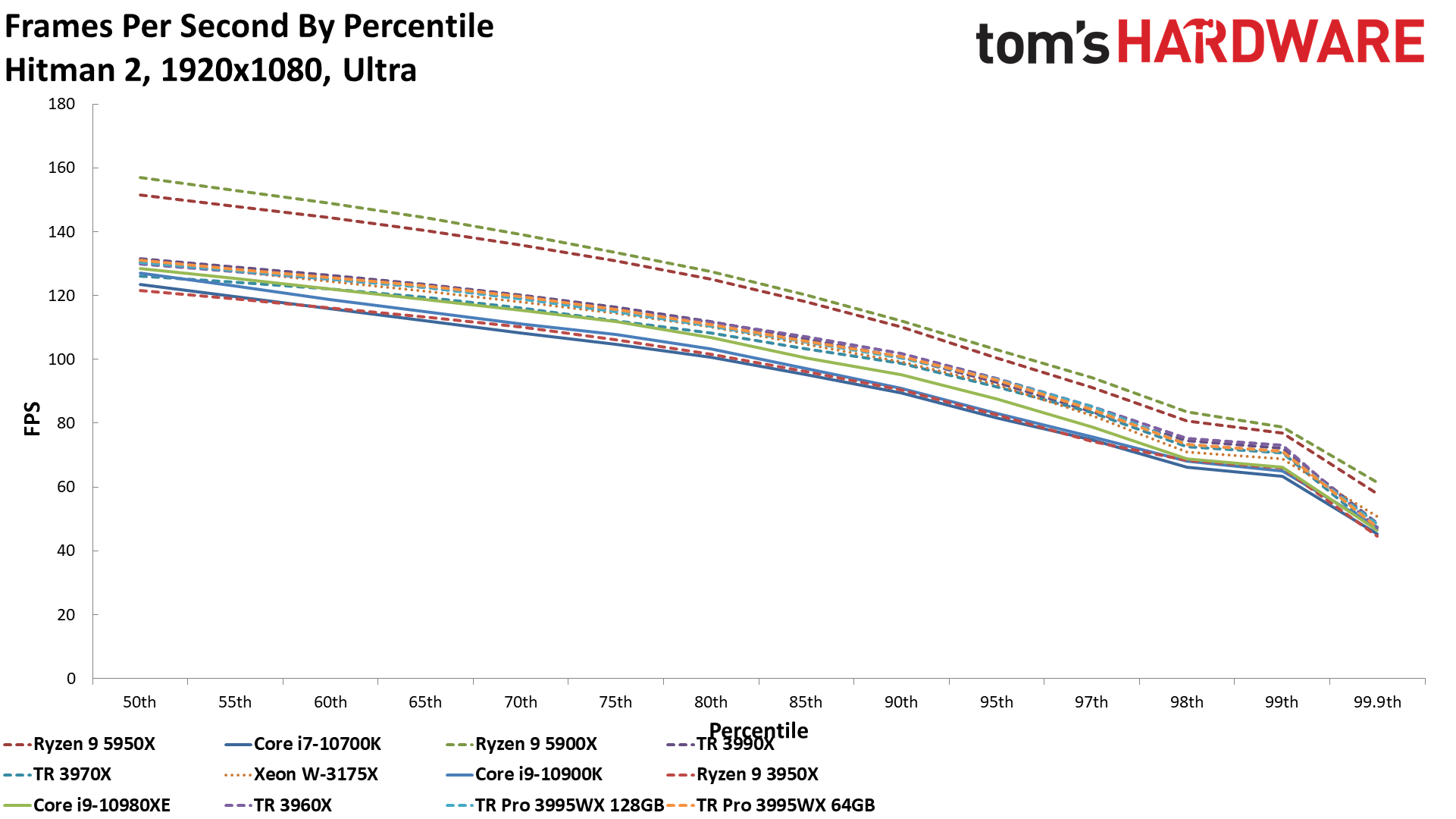
Hitman 2 doesn't seem to scale well from 1080p to 1440p, at least not at the heightened fidelity settings we use for the benchmark, so we stuck with the 1080p test for this title because the same trends carry over to 1440p. The 64GB Threadripper Pro configuration again outperforms the 128GB setup by the slimmest of margins while effectively tying the 3990X. The Xeon W-3175X takes a small lead, but the Core i9-10980XE trails most of the field.
Project CARS 3 on AMD Threadripper Pro 3995WX
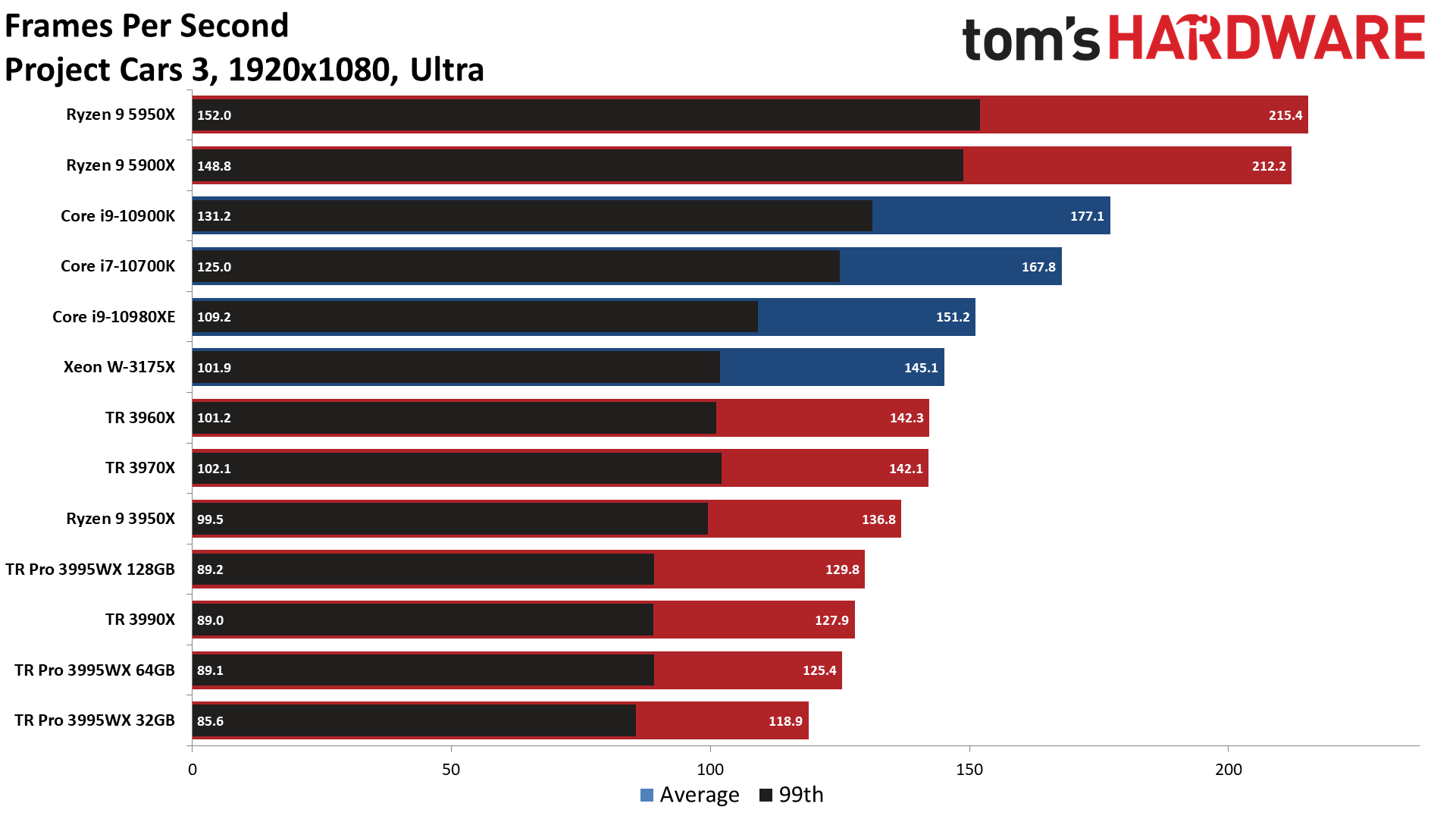
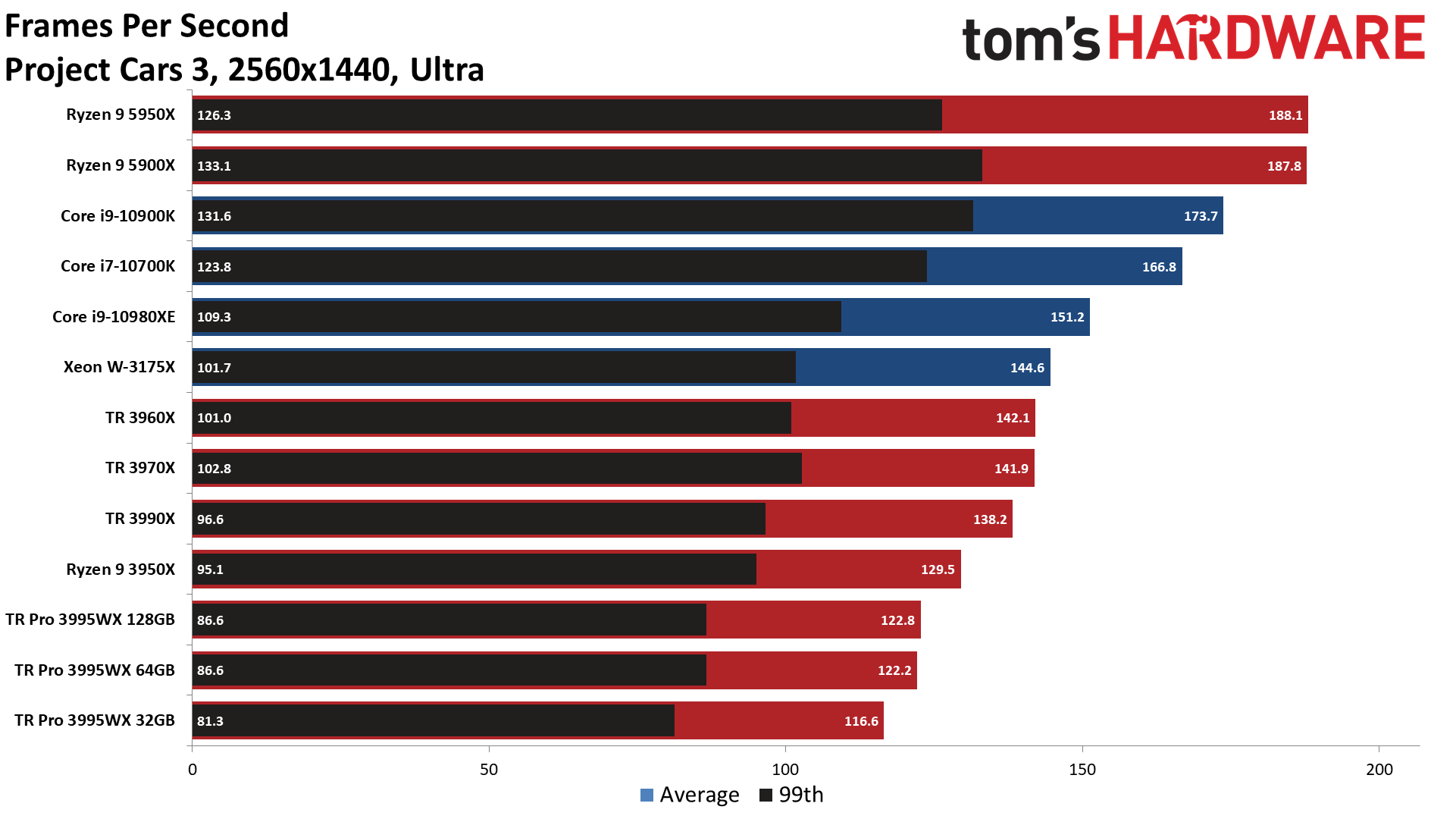

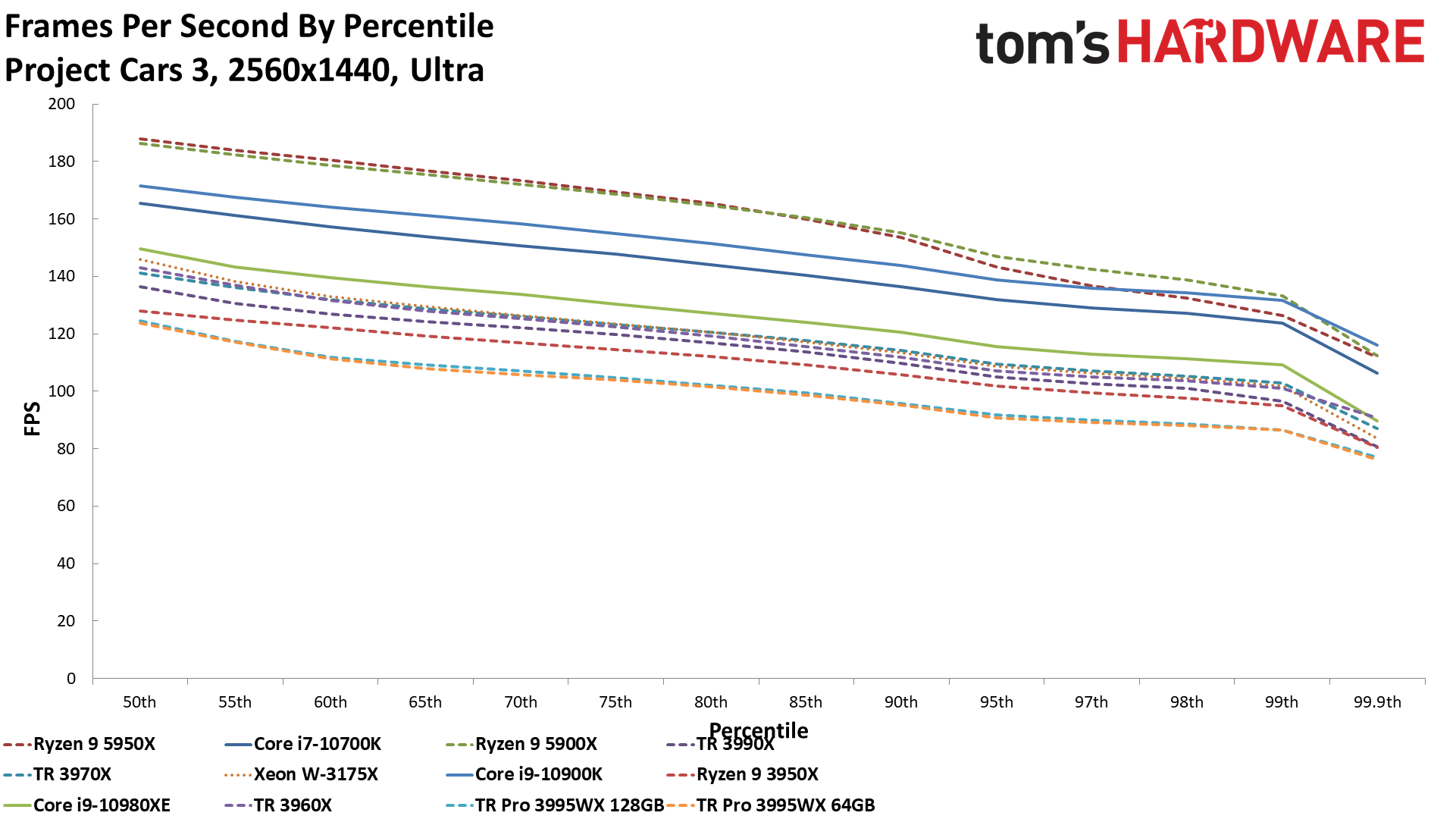
The Threadripper 3990X trails the 3995WX 128GB slightly in this title, but for reasons that remain unexplained, takes a big lead at 1440p.
Red Dead Redemption 2 on AMD Threadripper Pro 3995WX
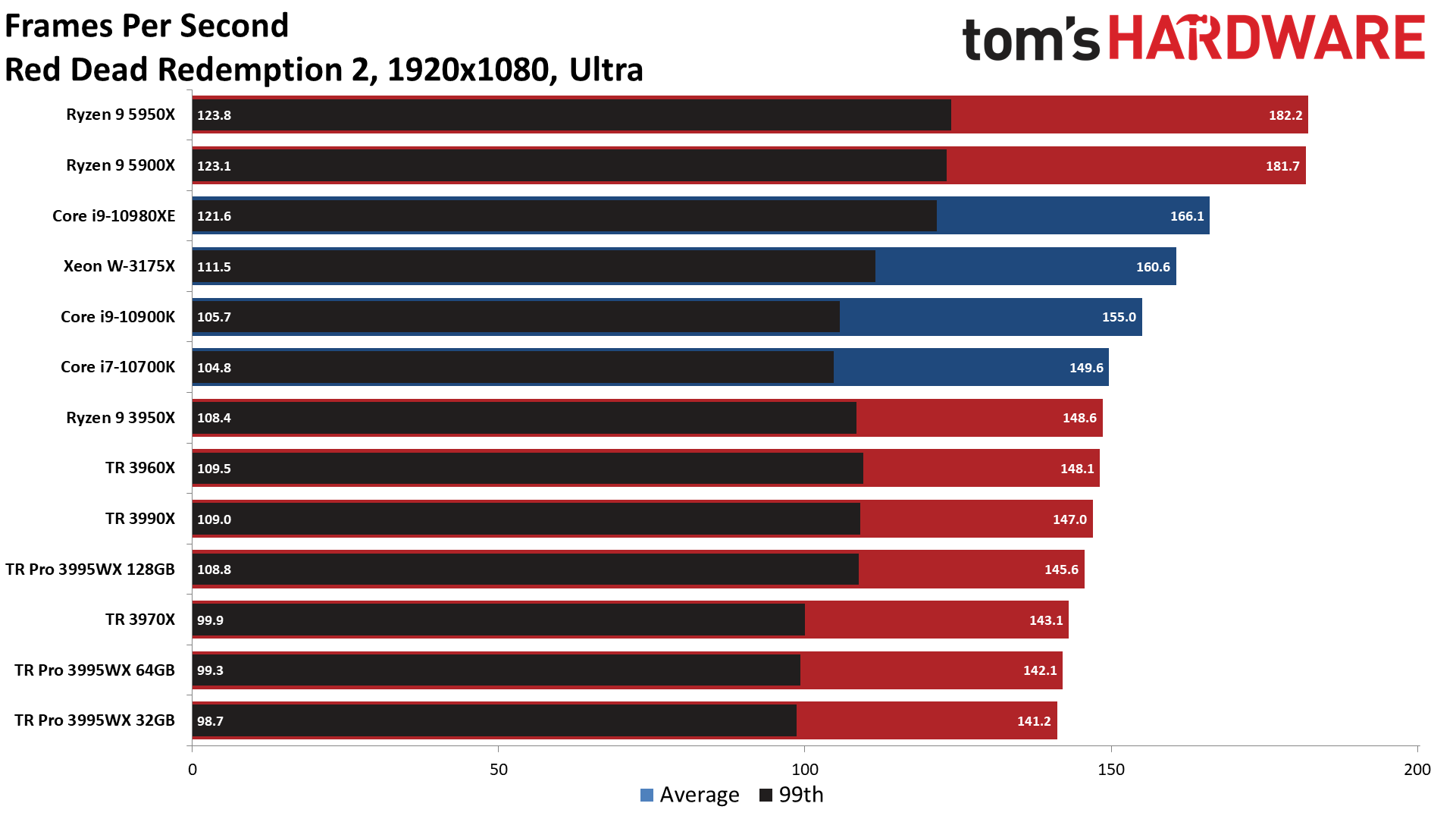
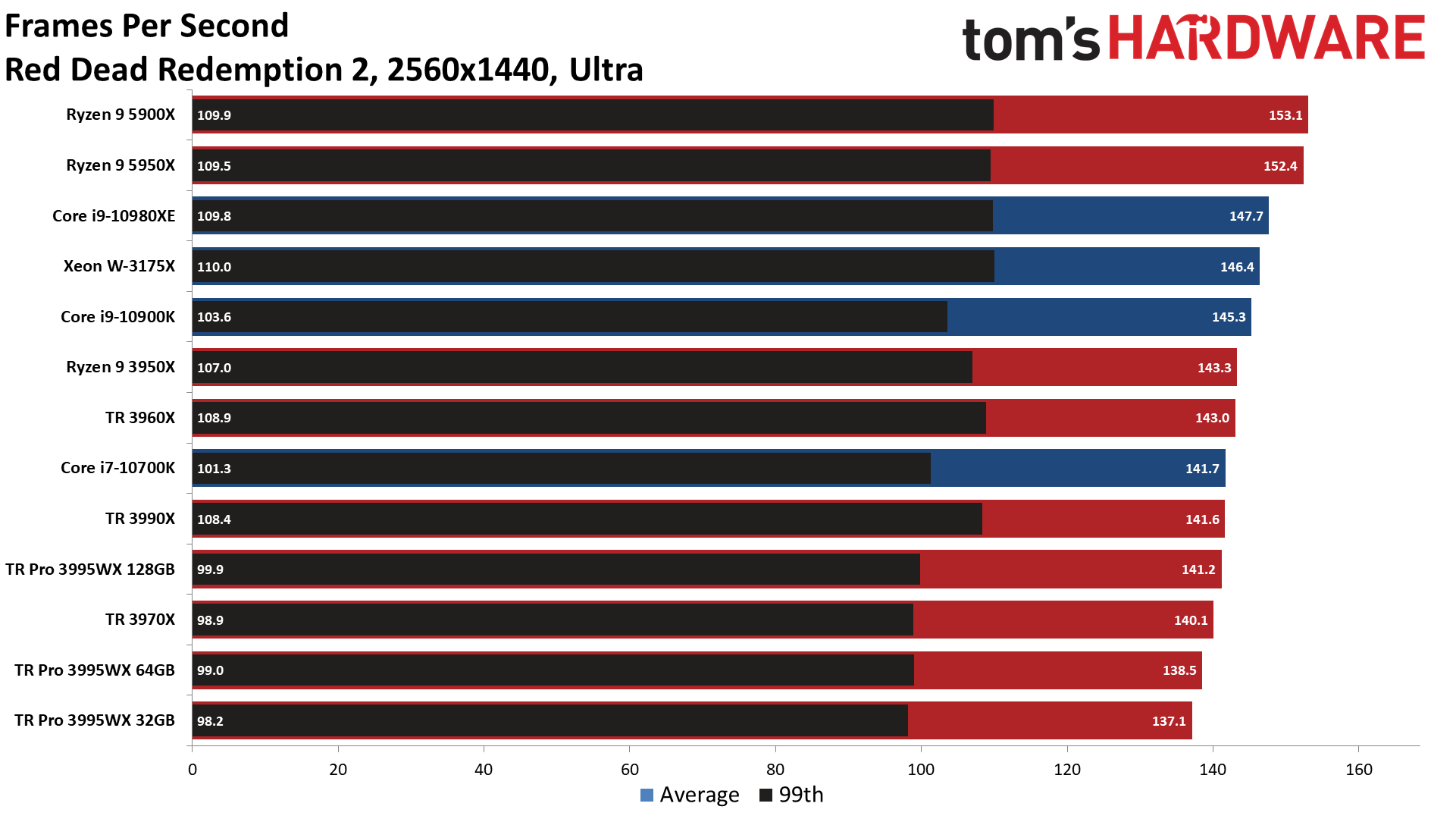
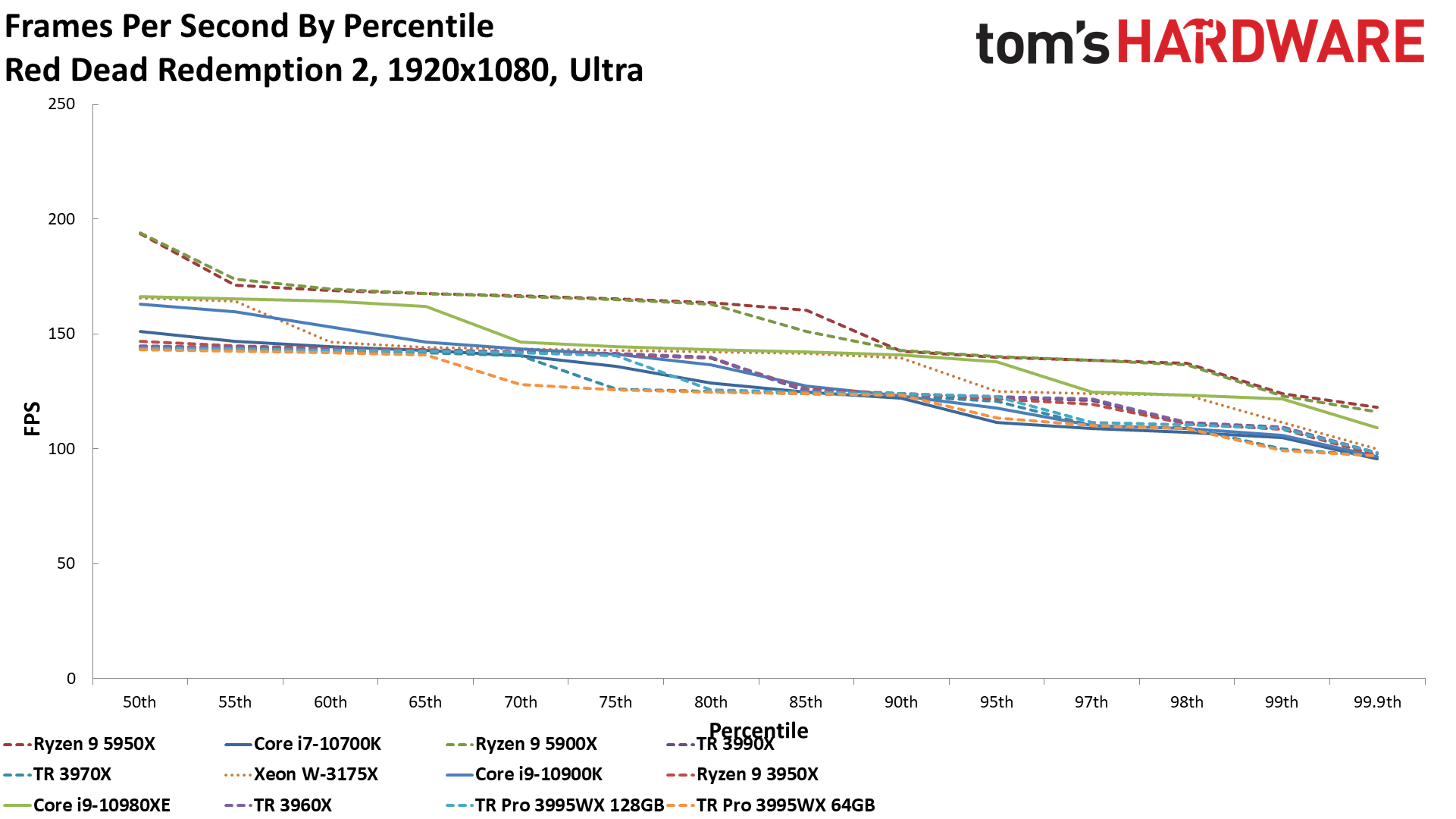
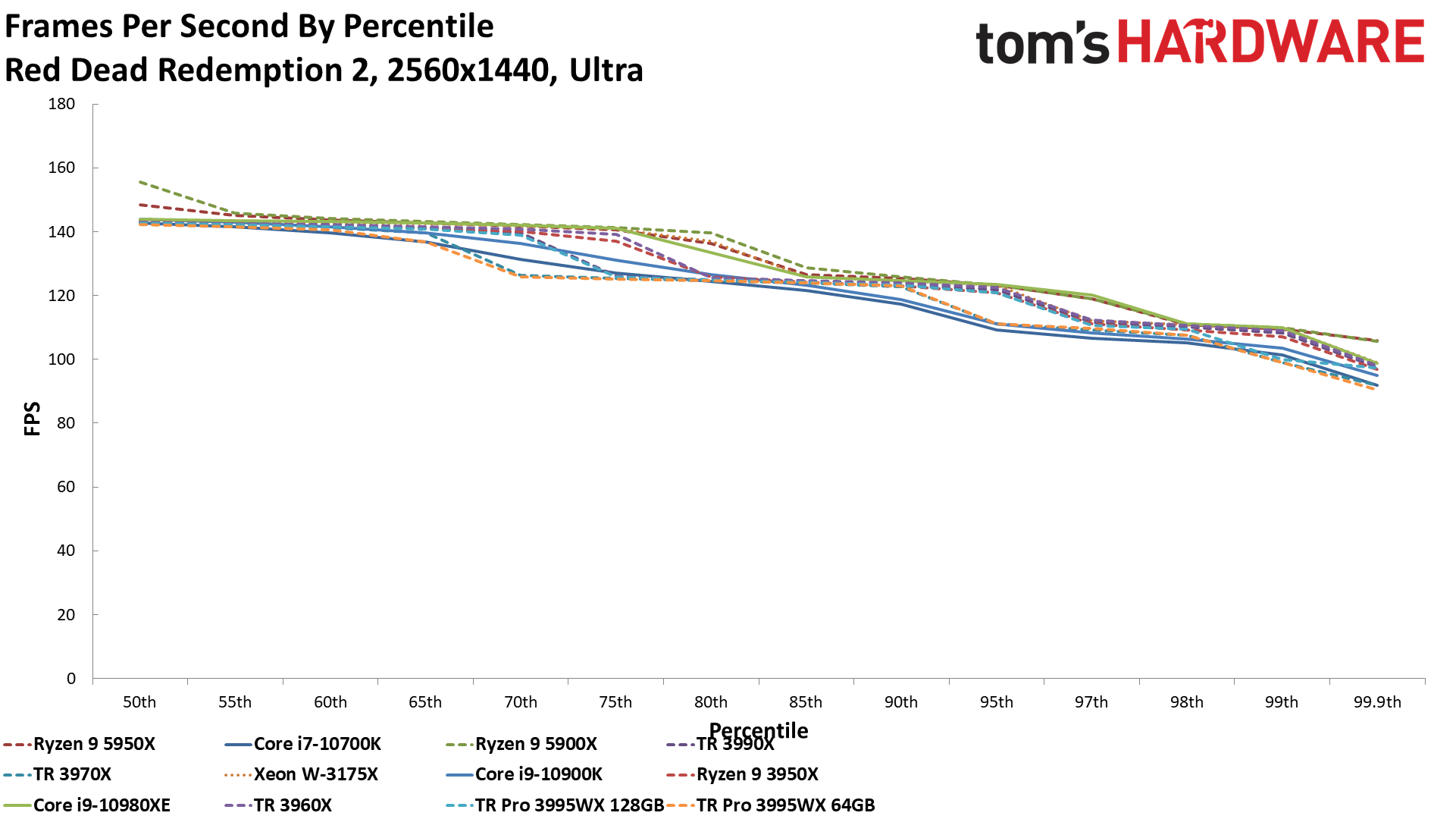
Shadow of the Tomb Raider on AMD Threadripper Pro 3995WX

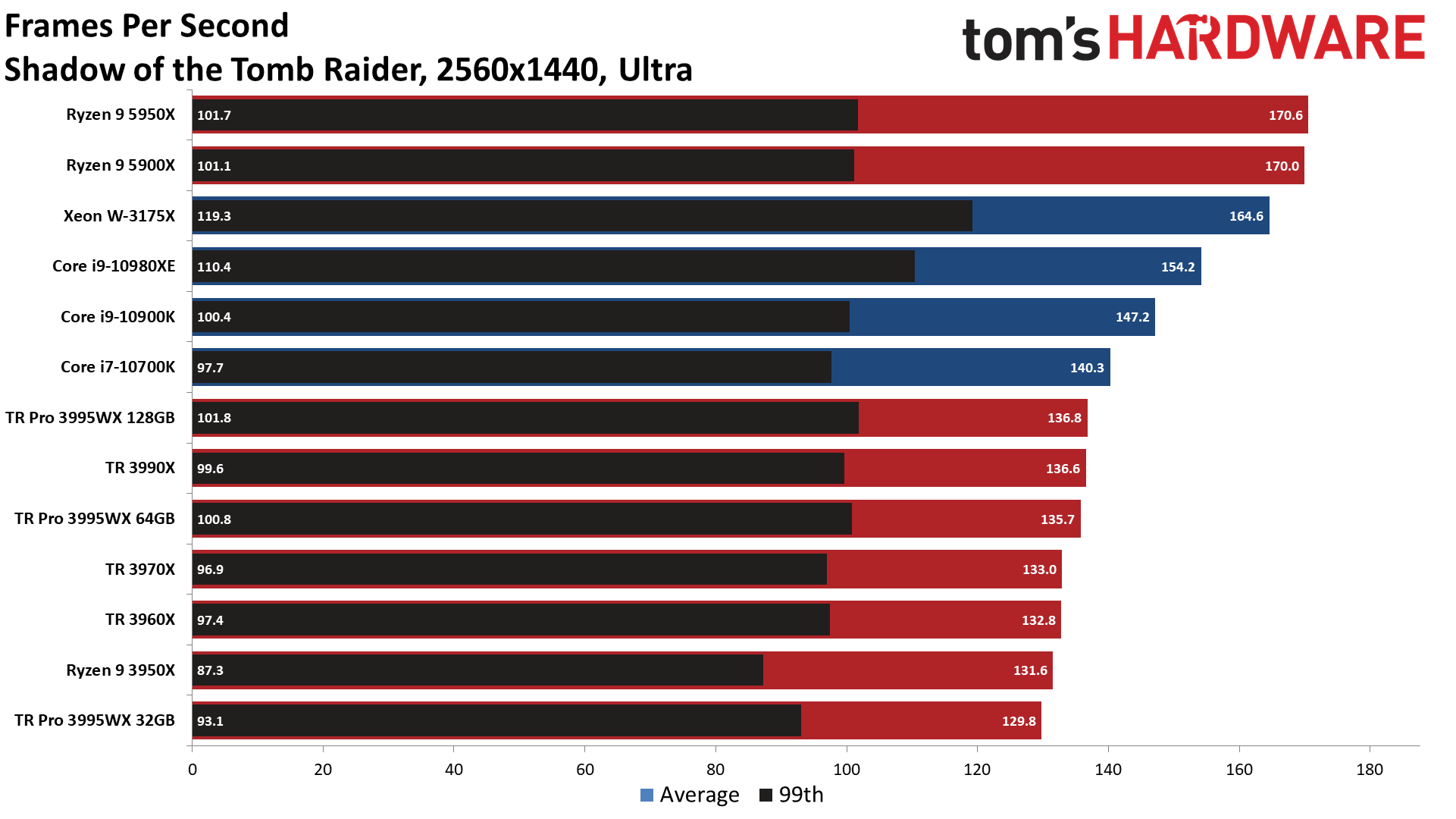
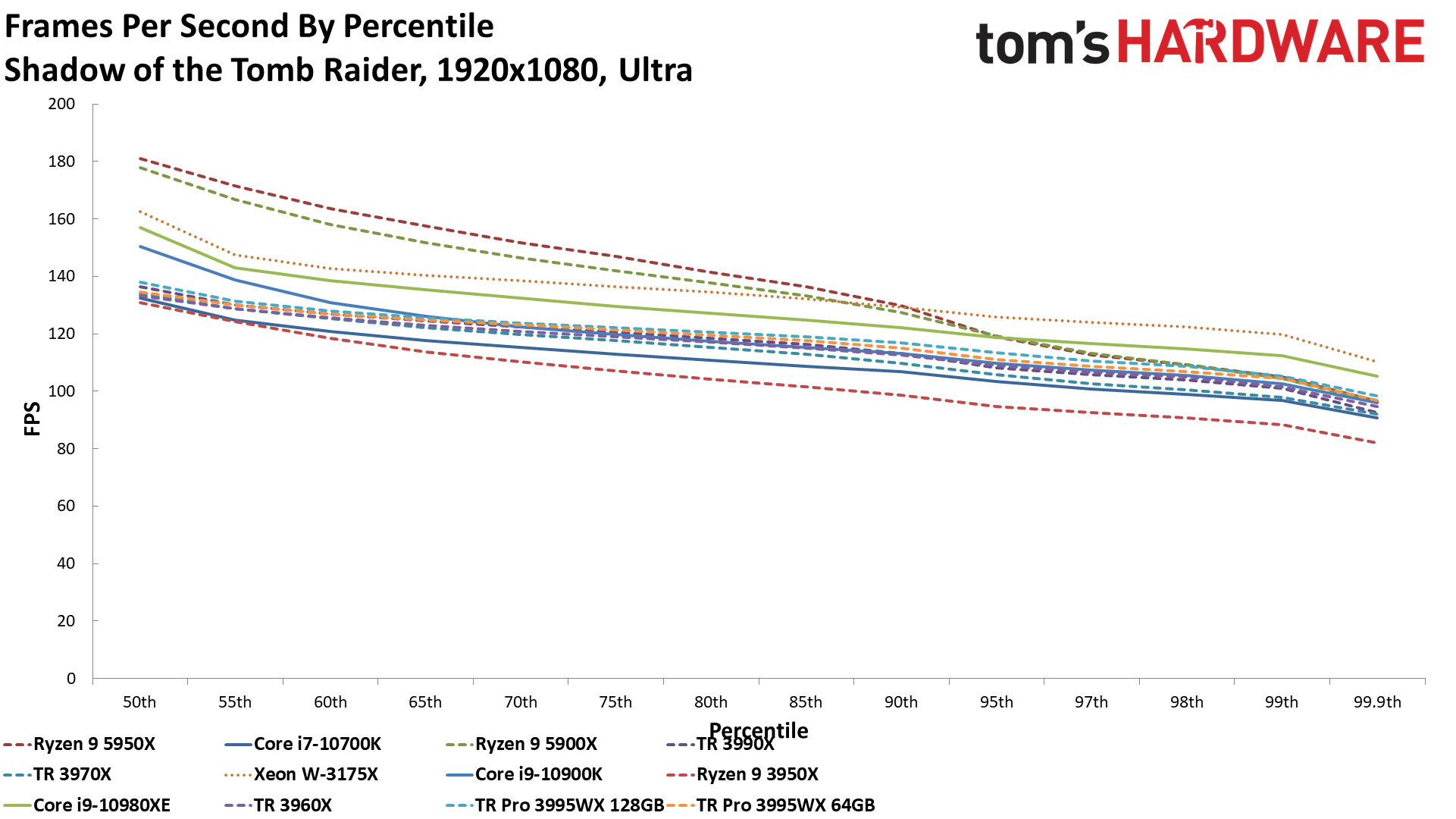
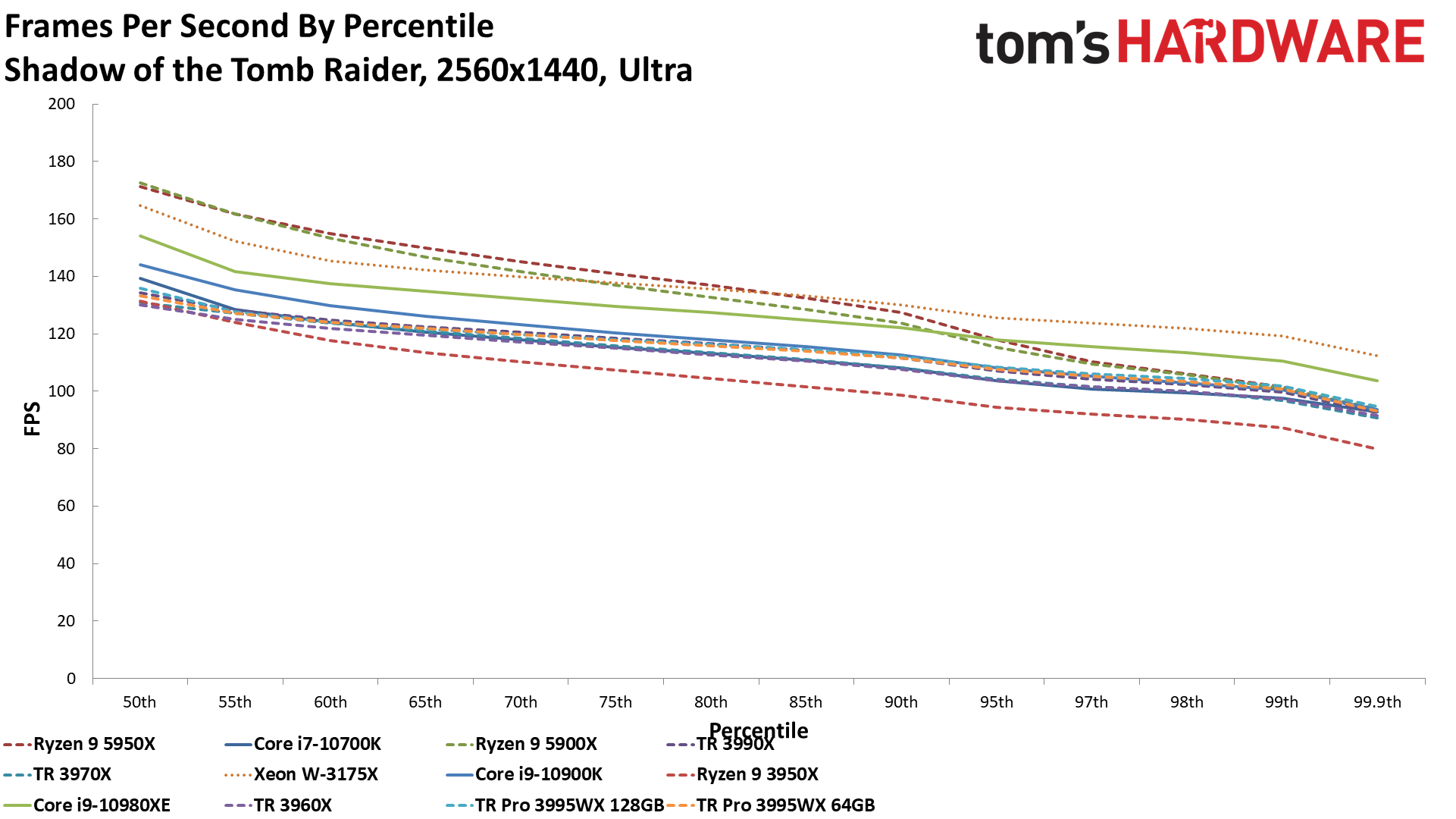
The Division 2 on AMD Threadripper Pro 3995WX
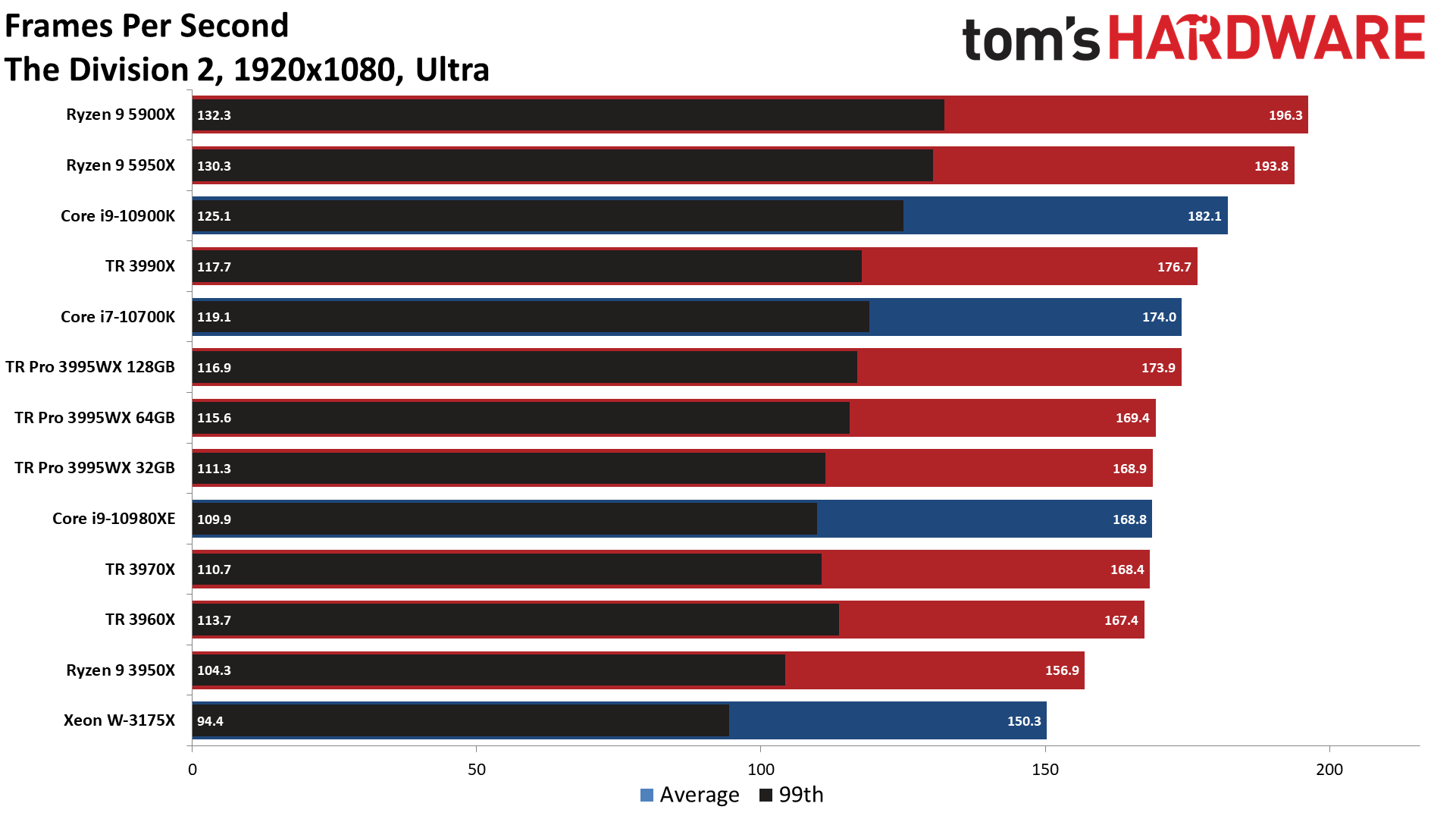

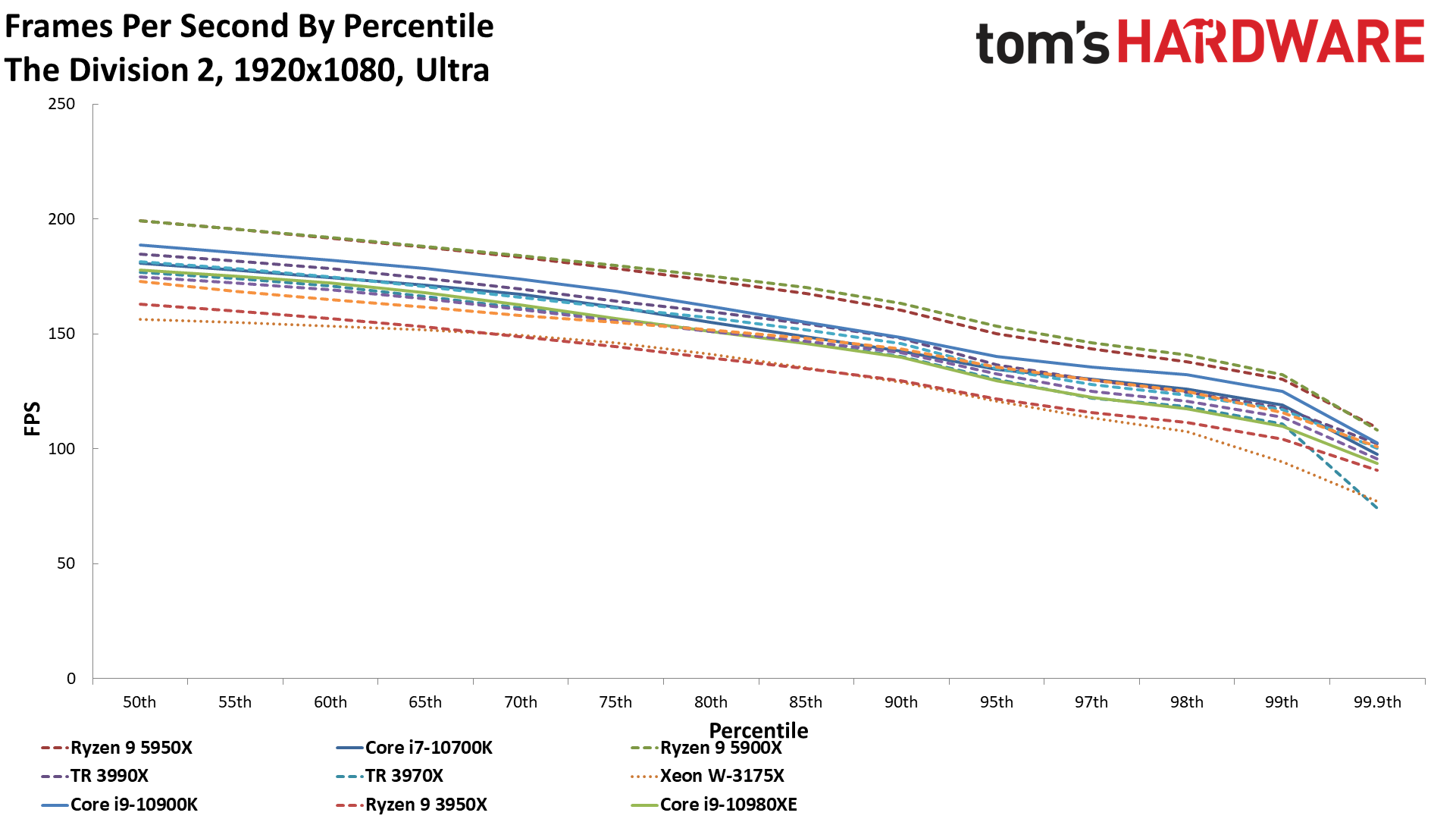
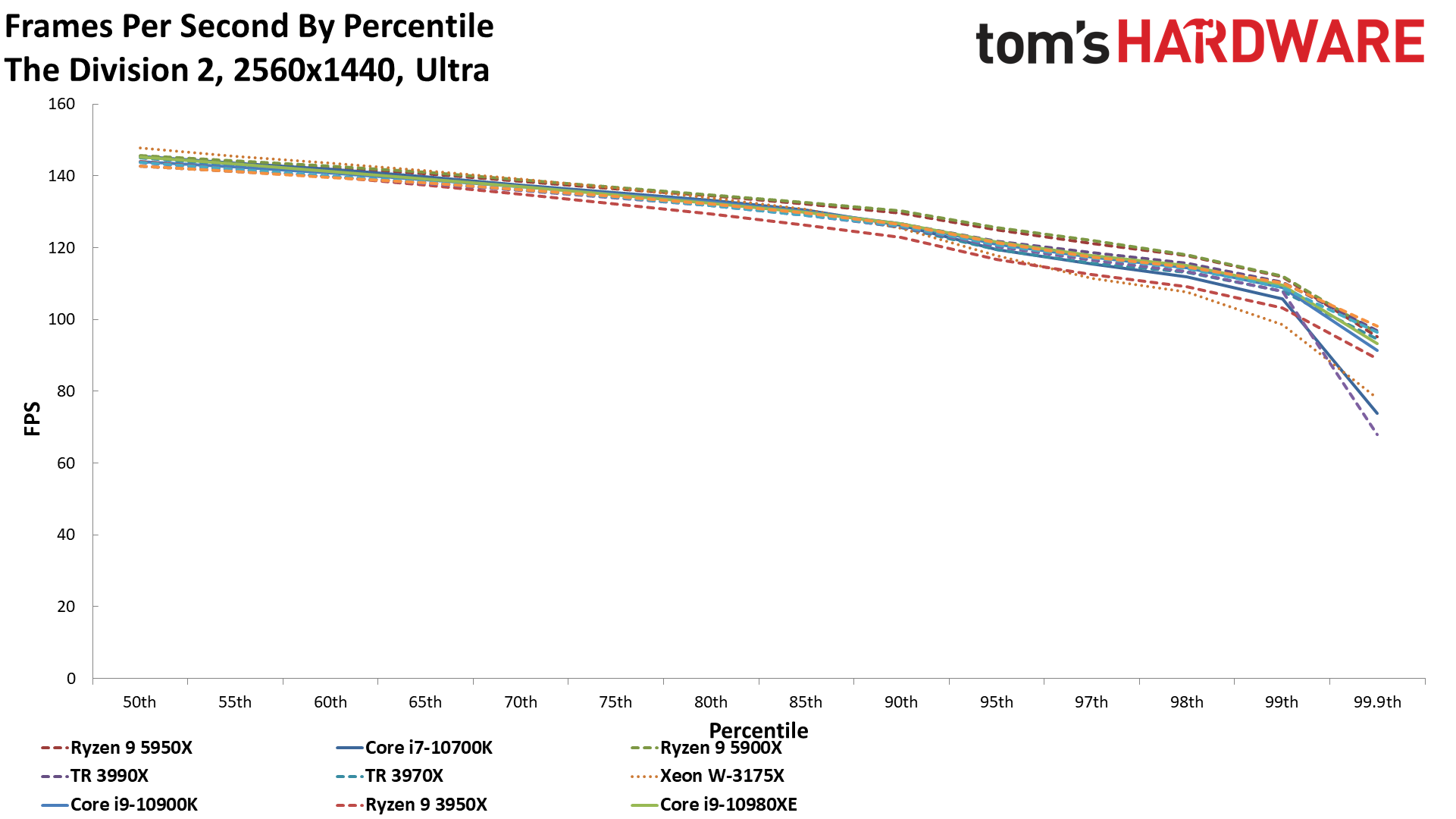
MORE: Best CPUs
MORE: Intel and AMD CPU Benchmark Hierarchy
MORE: All CPUs Content
Current page: AMD Threadripper Pro 3995WX Gaming Performance
Prev Page Threadripper Pro 3995WX Memory Scaling, Power, Thermals, Efficiency Next Page AMD Threadripper Pro 3995WX Desktop PC Application Performance
Paul Alcorn is the Editor-in-Chief for Tom's Hardware US. He also writes news and reviews on CPUs, storage, and enterprise hardware.
-
CerianK Probably a pointless question, but I assume the 16GB are dual-rank... I would be curious how 16GB single-rank (which I understand exist, but are the minority in the market) modules would perform in the 128GB configuration? Probably no difference, but might be worth exploring with a few select benchmarks, if possible.Reply -
gatg2 hate to be that guy but, it's not actually the first PCIe 4.0 capable workstation on the market, that honor goes to the Talos II Secure WorkstationReply
https://www.raptorcs.com/TALOSII/ -
fellow I love these, especially the 12-16 cores at 4GHz, much closer to 5900 and 5950 for lightly threaded workloads. Great solution for those wanting expandable server and workstation features.Reply
I like the look of those Raptors too, especially the pci-4 and memory bandwidth. May get a Blackbird for testing and open source (mostly) fast hardware. See Phoenix coverage Part 2— the first were not as promising.
For Threadripper Pro, has there been any information about the socket and CPU upgrade path?
My main concern is the upcoming release of Zen3 Threadrippers. I imagine there will then be a Zen3 Threadripper Pro in a couple quarters or a year from now. The memory and pci expansion makes this an excellent platform for future growth.
Since AMD has been forward looking by using the same socket for Ryzen, is it safe to expect the Zen3 TRPro will be accepted in this new socket?
Gracias,
fellow -
Endymio Reply... the most powerful workstation chip on the market - it's 64 cores easily outweigh Intel's
Emergency edit on aisle four, please.
Also, do I misunderstand the article, or has Toms yet again pronounced a verdict on a product they as yet haven't seen, or has even been released? -
Endymio Reply
Examine the highlighted word.Mandark said:Intel has nothing to touch the thread ripper so there’s nothing wrong with that statement -
hitchhiker0 Fantastic! I like them very much.Reply
Picking a Threadripper Pro 3975WX, 128 GB RAM, some SSD, some NVidia GPU and make a virtual desktop infrastructure for computer-aided designing.
You can host 4-6 virtual desktops quickly. -
Stefan Dyulgerov Hey in your benchmarks, can you include compilation of the Unreal Engine editor?Reply
The engine is quite taxing on the cpu both c++ and the shaders.
Most people that are alone struggle with it. If you work in studio you can share cores, but at home alone:) -
mikewinddale Nice review, thanks.Reply
But I just discovered something interesting that you missed in the review:
If you install six (6) dimms, applications like AIDA64, CPU-Z, etc. will recognize it as "hexa" channel, but benchmarks will reveal that the actual memory throughput is equivalent to merely dual-channel.
So you can populate four or eight DIMMs, but be careful with six.
For my application, I started a 3955WX with 4x64 GB RAM. I discovered that wasn't enough, so I upgraded to 6x64. My application now had enough RAM, but performance declined. So I had to upgrade to 8x64. -
robcowart @mikewinddale In my testing it is even worse than sticking to 4 or 8 populated channels. Anything less than all 8 channels has a significant impact on performance. The hardware setup for these tests was: 3995wx, ASUS Pro Sage, 256GB 3200MHz, writing to 4 x Samsung 980 Pro in RAID-0. Interesting is that while throughput dropped, meaning that technically the system is doing less work, the CPU utilization increased when all 8 memory channels weren't populated. I do wonder if the different channel-to-chiplet affinity between your 16-core and my 64-core model is responsible for why you don't see as big of a hit as I do with only 4 channels populated.Reply
